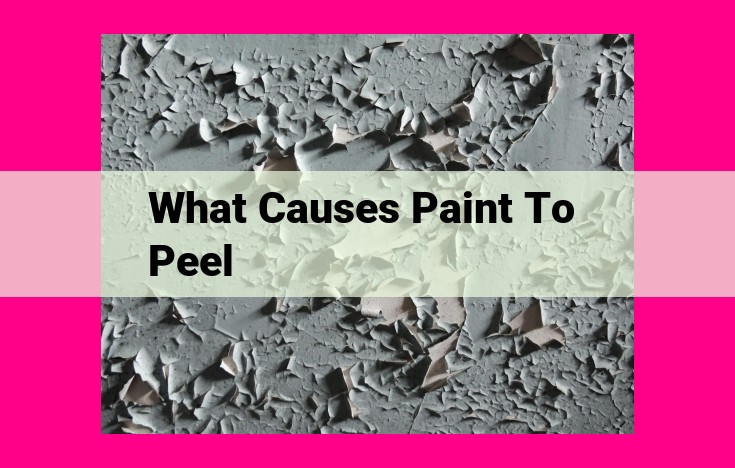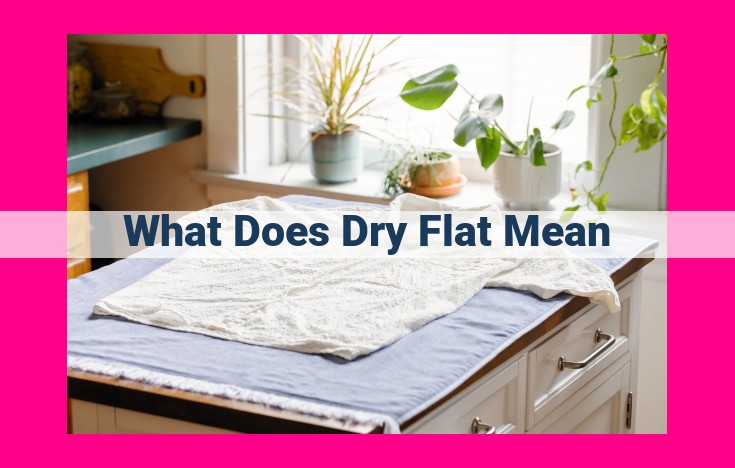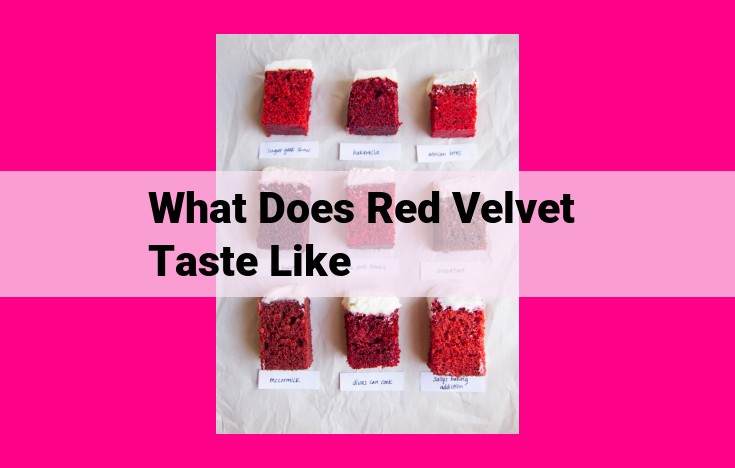Identifying And Resolving Common Causes Of Paint Peeling For Flawless Finishes

Paint peeling results from various factors. Inadequate surface preparation, including improper cleaning, sanding, or priming, creates uneven surfaces, poor adhesion, and trapped contaminants. Low-quality paint or primer lacks durability, while environmental elements like moisture, sunlight, and temperature can compromise paint adhesion. Lastly, incorrect application methods, such as over-thinning, improper coating, or insufficient drying time, can lead to paint failure.
The Vital Role of Surface Preparation for Paint Success
When it comes to painting, meticulous surface preparation is the cornerstone of a beautiful, long-lasting finish. Imagine a painter carefully crafting a masterpiece on a canvas. If the canvas is not properly cleaned, sanded, and primed, the painting will never achieve its full potential. Just as the canvas creates the foundation for the artwork, the surface you paint upon sets the stage for a flawless paint adhesion.
Why Surface Preparation is Crucial
Proper cleaning removes dirt, grease, and contaminants that can hinder paint adhesion and cause peeling later on. Sanding creates a smooth, even surface for the paint to grip onto, ensuring a strong bond. Priming seals the surface, providing a uniform base that enhances paint adherence and protects against moisture and stains.
Consequences of Inadequate Surface Preparation
Overlooking surface preparation is like building a house on a weak foundation. Contaminants, uneven surfaces, or poor adhesion can lead to paint failure: chipping, peeling, cracking, or bubbling. These flaws not only ruin the aesthetic appeal of your painted surfaces but also compromise their durability.
Expert Tips for Surface Preparation
- Use a TSP cleaner to thoroughly clean the surface and remove all dirt, grease, and contaminants.
- Sand the surface with fine-grit sandpaper to smooth out any imperfections and create a good “tooth” for the paint to adhere to.
- Apply a high-quality primer specifically formulated for the type of surface you are painting. Follow the manufacturer’s instructions for application and drying time.
Why Paint Fails: The Perils of Inadequate Surface Preparation
The success of any painting project hinges on meticulous surface preparation that ensures the paint adheres firmly to the substrate. When surfaces are not properly cleaned, sanded, or primed, a cascade of problems can arise, leading to premature paint failure and a diminished aesthetic appeal.
Contaminants: The Uninvited Guests
Tiny particles of dirt, grease, or dust can act as barriers between the paint and the surface, compromising adhesion. When contaminated surfaces are painted over, the paint has difficulty establishing a strong bond, and flaking or peeling can occur. Remember, a clean canvas is essential for a flawless finish.
Uneven Surfaces: The Bumps and Dents
Holes, cracks, or bumps on the surface can create uneven areas where paint thickness varies. These imperfections can lead to stress points in the paint film, making it more susceptible to cracking and chipping. By filling in imperfections and sanding the surface until it is smooth and uniform, you provide a stable foundation for the paint to adhere to.
Poor Adhesion: When Paint and Surface Refuse to Bond
The key to a successful paint job lies in the compatibility between the paint and the surface. When surfaces are not properly primed, the paint may not adhere sufficiently, resulting in blistering or peeling. Primers act as a bridge between the surface and the paint, ensuring a strong bond that resists the elements and stands the test of time.
Choosing Reputable Manufacturers for High-Quality Paints and Primers
When it comes to painting projects, the quality of your paint and primer can make all the difference. A **cheap or inferior paint may seem like a bargain at first, but it can end up costing you more in the long run due to poor coverage, fading, or peeling.
Choosing paint and primer from reputable manufacturers is like investing in a good pair of shoes. They’re not always the cheapest, but they’re built to last and will provide you with better results. These manufacturers have a proven track record of producing high-quality products that are designed to withstand the elements and provide long-lasting beauty.
High-quality paints and primers typically use better ingredients and have higher pigmentation levels, resulting in better coverage and a more durable finish. They are also less likely to fade, chip, or peel over time, saving you time and money on costly touch-ups and repainting.
Remember, the paint and primer you choose are the foundation of your paint project. Don’t compromise on quality. Invest in high-quality products from reputable manufacturers and enjoy the benefits of a long-lasting, beautiful finish that will bring you joy for years to come.
Common Painting Mistakes That Can Lead to Failure: A Guide to Avoiding Costly Re-dos
As DIY enthusiasts or home improvement contractors, we often embark on projects with the best intentions, expecting a flawless outcome. However, when it comes to painting, even the most experienced hands can encounter setbacks that can leave you frustrated and questioning your skills. Fortunately, by understanding the common pitfalls that can sabotage a paint job, you can take steps to prevent them and achieve the desired results.
The Importance of Surface Preparation: A Solid Foundation for a Lasting Finish
Just like a strong building needs a solid foundation, a flawless paint job requires proper surface preparation. Failure to adequately clean, sand, and prime surfaces before painting can lead to a host of problems that will inevitably compromise the finish. Contaminants, such as dirt, grease, or mildew, can prevent paint from adhering properly, resulting in peeling or flaking. Uneven surfaces, caused by inadequate sanding, can create an uneven paint application, leading to a rough or textured finish. Poor adhesion, due to skipping the priming step, can cause the paint to chip or wear off prematurely.
Paint Quality Matters: Choosing the Right Tools for the Job
When it comes to paint, not all products are created equal. Selecting high-quality paints and primers from reputable manufacturers is crucial for ensuring durability and minimizing the risk of failure. Different grades of paint, such as economy, premium, and professional, vary in terms of their composition, coverage, and longevity. Premium paints typically offer better coverage, resistance to fading and moisture, and overall durability. Professional-grade paints are designed for heavy-duty applications and provide the highest level of performance and longevity. Understanding the differences between these grades will help you make an informed decision based on your project’s specific requirements and budget.
Environmental Factors: The Silent Killers of Paint
As your paintbrush glides across the canvas of your home’s exterior, dreams of a vibrant, long-lasting masterpiece dance in your head. However, unbeknownst to you, there are sinister forces lurking in the shadows, ready to sabotage your dreams. Environmental factors like moisture, sunlight, and temperature have the potential to diminish the beauty and lifespan of your newly painted surfaces.
Moisture: The Enemy Within
Like a thief in the night, moisture stealthily infiltrates your paint film, breaking down its cohesive bond with the underlying surface. When water seeps into the microscopic pores of paint, it creates a breeding ground for mold and mildew. These unsightly growths not only mar the appearance of your home but also weaken the structural integrity of your paint. If left unchecked, moisture can lead to blistering, peeling, and the ultimate downfall of your paint job.
Sunlight: The Relentless Tormentor
The sun’s relentless rays are a double-edged sword for exterior paint. On the one hand, they help to dry paint quickly, allowing you to admire your fresh coat sooner. However, prolonged exposure to ultraviolet (UV) radiation can cause paint to fade, discolor, and become brittle. The intensity of the sunlight and the angle at which it strikes your home will determine the severity of the damage. South-facing walls, for instance, receive the brunt of the sun’s assault and are more prone to sun damage than their shady counterparts.
Temperature: The Balancing Act
Temperature plays a crucial role in the performance of paint. Extreme heat can cause paint to dry too quickly, leading to cracking and peeling. Conversely, excessively cold temperatures can hinder the drying process and make the paint more susceptible to moisture damage. The ideal temperature for painting ranges between 50 and 85 degrees Fahrenheit. Painting outside of these parameters can compromise the durability of your paint job.
Tips for Combating Environmental Factors
Don’t let environmental factors rain on your painting parade. Here are some tips to protect your painted surfaces and ensure their longevity:
- Moisture: Apply a moisture-resistant primer to act as a barrier against water intrusion. Ensure proper drainage around your home and seal any cracks or gaps where water can penetrate.
- Sunlight: Use high-quality paints that contain UV inhibitors to shield against fading and discoloration. Consider using awnings, umbrellas, or landscaping to provide shade for exposed areas.
- Temperature: Plan your painting projects for times when the weather is cooperative. If you must paint in extreme temperatures, take precautions to mitigate their impact.
Shield Your Painted Surfaces: Tips to Withstand Environmental Assaults
# Environmental Factors and Paint Longevity
Environmental elements can pose a formidable challenge to the durability of your freshly painted surfaces. Understanding how these factors influence paint adhesion and longevity is crucial for safeguarding your investment.
## Moisture: The Silent Enemy
Moisture, whether from rain, condensation, or humidity, can seep into paint and cause it to blister, peel, and crack. To combat this insidious enemy, opt for moisture-resistant paints, especially for exterior surfaces, bathrooms, and kitchens. Ensure proper ventilation to prevent moisture buildup, and consider applying a waterproofing sealant to vulnerable areas.
## Sunlight: The Color-Fading Culprit
The sun’s relentless rays can wreak havoc on your paint by fading its pigments and causing it to lose its vibrancy. To mitigate this damaging effect, choose UV-resistant paints specifically formulated to withstand prolonged exposure to sunlight. Consider adding awnings or latticework to provide shade for exposed surfaces, and apply regular touch-ups to maintain their pristine appearance.
## Temperature Swings: The Paint-Stressing Stressors
Extreme temperature fluctuations can put stress on your paint film, leading to cracking and chipping. Select temperature-resistant paints that can withstand the wide temperature variations in your region. Avoid painting surfaces during extremely hot or cold conditions, as this can interfere with proper adhesion.
Avoid Paint Failure: Master the Art of Proper Application
When it comes to painting, meticulous application is the key to a flawless and long-lasting finish. Neglecting this crucial step can lead to paint failure, leaving you with an unsatisfying result. Here’s how to ensure your painting project stands the test of time:
Embracing Proper Brushwork:
-
Choose the right brush: Opt for high-quality brushes designed for your specific paint type. Natural bristles work well for oil-based paints, while synthetic bristles are ideal for water-based ones.
-
Brush with care: Use gentle, even strokes, avoiding overbrushing that can thin the paint and compromise its coverage.
-
Pay attention to details: Cut in around edges and corners with a smaller brush for a crisp and precise finish.
Mastering Spraying Techniques:
-
Prepare the surface: Ensure the surface is clean, sanded, and primed to provide a smooth base for the paint.
-
Adjust the settings: Calibrate your sprayer according to the paint manufacturer’s instructions to achieve optimal spray coverage.
-
Overlap your strokes: Apply thin, even coats, overlapping slightly on each pass to prevent streaks or gaps.
-
Distance matters: Hold the sprayer at the recommended distance from the surface to avoid runs or drips.
Additional Tips:
-
Avoid thinning excessively: Follow the manufacturer’s guidelines for thinning the paint to prevent compromising its adhesive properties.
-
Allow for proper drying: Give each coat ample time to dry before applying the next, ensuring a strong bond between layers.
-
Protect from the elements: If painting outdoors, consider weather conditions and protect the painted surface from direct sunlight, rain, or extreme temperatures.
Remember, the key to successful painting lies in the details. By following these proper application techniques, you can achieve a professional-looking finish that will enhance the beauty and longevity of your painted surfaces.
How Improper Paint Application Leads to Disastrous Paint Failure
When embarking on a painting project, meticulous attention to detail is paramount. Proper application techniques not only enhance the aesthetic appeal of your masterpiece but also ensure its longevity. However, oversights or errors in the application process can lead to premature paint failure, leaving you with a frustrating and costly mess.
The Perils of Over-Thinning
Paint is not a magic potion that can be diluted indefinitely. Adhering to the manufacturer’s recommended thinning ratio is crucial. Over-thinning weakens the paint’s film-forming properties, resulting in a thin, ineffective layer that lacks durability and adhesion. This diluted paint is more susceptible to chipping, peeling, and fading under the relentless assault of environmental factors.
Uneven Coating: A Patchwork of Problems
Even the most pristine surface preparation can be undermined by uneven coating. Applying paint inconsistently creates areas with varying thicknesses, leading to a patchwork effect. Thinner sections are more vulnerable to damage, becoming the weak links that ultimately compromise the entire paint job. Additionally, uneven coating can result in splotches, streaks, and an overall amateurish appearance.
Inadequate Drying Time: A Recipe for Disaster
Insufficient drying time is a ticking time bomb for paint failure. Impatience can lead to applying subsequent coats before the previous layer has fully dried. This premature layering traps moisture and solvents within the paint film, causing it to blister, wrinkle, and peel. Moreover, under-dried paint is less resistant to everyday wear and tear, leaving it vulnerable to scratches and dents.
Prevention is Key: The Path to Paint Success
Avoiding these application pitfalls is the key to a successful paint job. Always prepare surfaces thoroughly, choose high-quality paint, and apply it according to the manufacturer’s instructions. Allow ample drying time between coats, and resist the temptation to cut corners. By following these steps, you can ensure that your newly painted surfaces will stand the test of time, giving you years of worry-free enjoyment.





